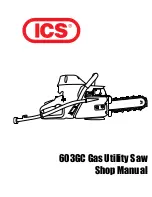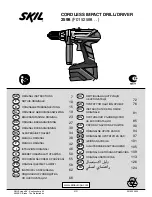
31 ENGLISH
Workpieces up to 46 mm high and 92 mm wide can be
cut in the following manner.
1.
Secure the
workpiece with the vise.
2.
Switch on the tool without the blade making
any contact and wait until the blade attains full speed
before lowering.
3.
Gently lower the handle to the fully lowered
position to cut the workpiece.
4.
When the cut is completed, switch off the
tool and
wait until the blade has come to a complete
stop
before returning the blade to its fully elevated
position.
Refer
to
the
previously covered
"Adjusting the
miter
angle".
Bevel cut
WARNING:
After setting the blade for a bevel
cut, before operating the tool ensure that the saw
head and blade will have free travel throughout
the entire range of the intended cut.
Interruption of
the saw head or blade travel during the cutting
operation may result in kickback and serious personal
injury.
WARNING:
While making a bevel cut keep
hands out of the path of the blade.
The angle of the
blade may confuse the operator as to the actual blade
path while cutting and contact with the blade will result
in
serious
personal
injury
WARNING:
The blade should not be raised
until it has come to a complete stop.
During a
bevel cut the piece cut off may come to rest against
the blade. If the blade is raised while it is rotating the
cut-off
piece
maybe
ejected
by
the
blade
causing
the
material to fragment which may result in serious
personal
injury.
WARNING:
Always remove sub-fence when
performing bevel cuts.
Failure to do so may cause
serious
injury.
►
Fig.47
1.
Loosen the lever and tilt the saw blade to set
the bevel angle
(Refer
to
the
previously covered
"Adjusting the
bevel
angle").
Be
sure
to
retighten
the
lever
firmly
to
secure
the selected bevel angle safely.
2.
Secure
the workpiece with the vise.
3.
Switch on the tool without the blade making
any contact and wait until the blade attains full speed.
4.
Gently lower the handle to the fully lowered
position while applying pressure in parallel with the
blade to cut the workpiece.
5.
When the cut is completed, switch off the
tool and
wait until the blade has come to a complete
stop
before returning the blade to its fully elevated
position.
NOTICE:
When pressing down the handle, apply
pressure in parallel with the blade.
If a force is
applied perpendicularly to the turn base or if the
pressure direction is changed during a cut, the
precision of the cut will be impaired.
Compound cutting is the process in which a bevel angle
is made at the same time in which a miter angle is being
cut on a workpiece. Compound cutting can be
performed at the angle shown in the table.
Miter angle
Bevel angle
Left and right 45°
Left and righ
t 0° - 45°
Right 52°
Left 20° - Right 45°
Left 52°
Left 45° - Right 20°
When performing compound cutting, refer to "Press
cutting", "Miter cutting" and "Bevel cut" explanations.
Cutting aluminum extrusion
►
Fig.48:
1.
Vise
2.
Spacer block
3.
Guide
fence
4.
Aluminum extrusion
5.
Spacer block
When securing aluminum extrusions, use spacer blocks
or pieces of
scrap
as
shown
in
the
figure
to
prevent
deformation
of
the
aluminum.
Use a cutting lubricant when cutting the aluminum
extrusion to prevent build-up of the aluminum material
on the blade.
CAUTION:
Never attempt to cut thick or round
aluminum extrusions.
Thick aluminum extrusions
may come loose during operation and round
aluminum extrusions cannot
be
secured
firmly
with
this
tool.
Cutting repetitive lengths
When cutting several pieces of stock to the same
length, ranging from 200 mm to 330 mm, use the set
plate (optional accessory). Install the set plate on the
holder
(optional
accessory) as
shown
in
the
figure. ►
Fig.49:
1.
Set
plate
2.
Holder
3.
Screw
Align the cutting line on your workpiece with either the
left or right side of the groove in the kerf board, and
while holding
the
workpiece, move
the
set
plate
flush
against
the
end
of the workpiece. Then secure
the set plate with the screw. When the set plate is not
Miter cutting
Compound cutting
Summary of Contents for DLS600
Page 2: ...2 ...
Page 3: ...3 9 10 Fig 2 ...
Page 4: ...4 Fig 3 Fig 6 ...
Page 5: ...5 Fig 7 ...
Page 6: ...6 ...
Page 7: ...7 2 3 Fig 20 Fig 17 Fig 21 2 Fig 22 1 ...
Page 8: ...8 Fig 19 Fig 23 Fig 24 Fig 25 Fig 29 1 2 1 ...
Page 9: ...9 Fig 26 Fig 30 Fig 27 Fig 31 2 Fig 32 1 3 2 1 ...
Page 10: ...10 Fig 33 Fig 35 1 3 5 Fig 36 3 2 4 6 ...
Page 11: ...11 2 3 Fig 34 1 Fig 38 Fig 42 1 3 6 Fig 39 2 3 4 5 2 4 5 ...
Page 12: ...12 1 Fig 40 3 Fig 41 Fig 45 2 3 4 5 6 1 ...
Page 13: ...13 Fig 46 Fig 47 Fig 51 1 2 4 5 Fig 48 Fig 52 2 3 ...
Page 14: ...14 1 2 Fig 49 1 Fig 58 Fig 55 1 2 3 Fig 59 3 2 3 ...
Page 15: ...15 Fig 56 3 Fig 60 1 2 2 1 Fig 61 Fig 62 1 ...
Page 16: ...16 Fig 65 Fig 66 Fig 64 Fig 67 1 2 3 4 5 1 ...
Page 22: ...22 ENGLISH a hot battery cartridge cool down before charging it ...
Page 224: ...885605 992 ...
Page 225: ...Anjo Aichi 446 8502 Japan www makita com EN FR DE IT NL ES PT DA EL TR 20170524 ...
Page 226: ......
















































